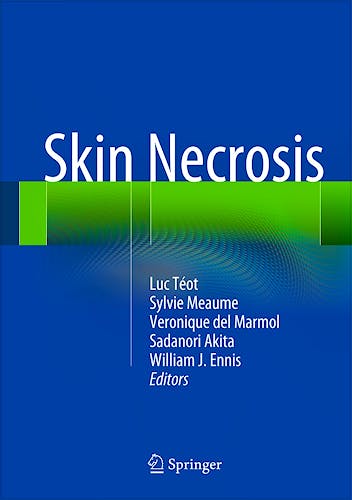

There are no products in the cart.



Skin Necrosis
Teot, L. — Meaume, S. — Del Marmol, V. — Akita, S. — Ennis, W.
1ª Edition March 2015
English
Hard Cover
350 pags
1500 gr
21 x 28 x null cm
ISBN 9783709112403
Publisher SPRINGER
Printed Book
-5%
103,99 €98,79 €VAT included
99,99 €94,99 €VAT not included
Receive it within
2 - 3 weeks
About this book
- Offers a comprehensive, multidisciplinary approach to the subject Clearly and concisely written chapters with demonstrative illustrations With contributions by an international team of leading experts in the field
In recent years, wound care has gained increasing recognition as a distinct medical specialty. An understanding of the complex mechanisms in wound healing facilitates efficient assessment and treatment of patients with wounds. Skin necrosis can be considered the starting point in the entire process of wound healing.
This book is the first to discuss skin necrosis as a symptom related to a large series of pathologies. The richly illustrated volume provides therapeutic strategies and treatment algorithms for different clinical contexts. Each chapter is written by renowned specialists in their respected fields and contains detailed case vignettes and key take-home messages.
Taking into account the highly interdisciplinary and multi-professional aspect of wound management, Skin Necrosis will prove an invaluable resource for wound care practitioners and health care professionals across the fields of surgery, dermatology, internal medicine, and nursing.
Table of contents
Definitions, physiopathology, imaging.- 1. Cyanosis congestion and skin necrosis. Is necrosis a venous congestion at the origin? (S. Meaume).- 2. Ischaemia reperfusion injury (T.K. Hunt).- 3. Dry vs wet necrosis (H. Justiniano).- 4. Extension in depth (S. Akita).- 5. X-ray imaging of necrotic skin (tbd).- Different clinical context of skin necrosis.- 6. Vasoactive drugs (tbd).- 7. Necrotising angiodermatitis (tbd).- 8. Rheumatoid and systemic collagenosis vasculitis (F. Massaki).- 9. Cold induced necrosis (tbd).- 10. Cryoglobulinemia (tbd). - 11.- Calciphylaxy (M. Romanelli).- 12. Necrotic burns (R. Horch).- 13. Purpura fulminans (tbd).- 14. Fournier gangrene (tbd).- 15. Envenimations (tbd).- 16. Toxic syndromes. Systemic management (tbd).- 17. Necrotising fasciitis (S. Akita).- 18. Tumoral (I. Fromantin).- 19. Infection and skin necrosis (D. Leaper).- 20. Post-injection Interferon, high-viscosity products, anticoagulants warfarin, coumadin, vasopressive drugs (tbd).- 21. Pyoderma gangrenosum (tbd).- 22. Trauma, degloving, scalps (R. Strockmayer).- 23. Pressure ulcer necrosis in geriatric, in paraplegic patients in ICU (tbd).- 24. Pressure ulcers in neonates (G. Ciprandi) .- 25. Arterial leg ulcer and chronic arteriopathy (B. Ennis).- 26. Necrotic skin and diabetes (tbd).- 27. Arteriovenous fistulae and vascular thief (tbd).- 28. How to manage necrotic flap failure (R. Horch).- 29. Kwashiorkor, HIV, and palliative care of necrotic nodes (tbd).- 30. Haematomas (S. Meaume).- 31. Necrotic and exposed tendon (L. Téot).- 32. Necrotic skin covering osteosynthetic material (G. Jukema).- 33. Abdominal wall necrosis (O. Chappuis).- Techniques applicable to skin necrosis.- 34. Dressings available to debride. The nurse domain (tbd).- 35. Different regulations of nursing debridement depending on the country (K. Tanaka, N.L. Tomaselli, E. Ribal).- 36. Surgical debridement (S. Akita).- 37. Negative pressure therapy. A contraindication to skin necrosis (tbd).- 38. Recent technologies in necrosis debridement (L. Téot).- 39. Stabilisation of necrotic tissue using cerium nitrate silvesulfadiazine (C. Trial).
© 2025 Axón Librería S.L.
2.149.0